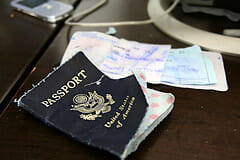You shouldn’t travel with a damaged passport. But how damaged does it have to be before it’s considered unusable? If you travel frequently, your passport will eventually end up in less-than-pristine condition. How do you tell the difference between “normal, acceptable wear and tear” and “too damaged to travel”?
What is a Damaged Passport?
So, should a crease in the back of your passport keep you from traveling? Not according to the Department of State, which told the news station, “From Passport Services perspective this problem seems to originate with the airlines. We generally don’t consider a crease to be damaged or mutilated such that it would prevent travel.”
According to the State Department’s website, the following conditions DO qualify as damage:
- Water Damage
- A rip or tear
- Markings on personal data page
- Visa pages that have been torn out
- A hole punch
- Other significant injuries
Of course, once the airline denies you boarding, being in the right is cold comfort. If your passport shows enough wear and tear to be a concern, you may choose to renew it as a precaution.
If your passport is damaged, you’ll need to apply for a replacement in person. See our help center for more details on what to do.
What happens when you travel with a damaged passport?
As one Colorado family learned recently, even normal wear and tear can leave you grounded. Kyle, Dana, and little Kyle Gosnell were all set to head to Belize for a beach vacation.

Unfortunately, Kyle Gosnell’s well-used, well-loved passport had a large crease on the back cover. Though the family received boarding passes from Denver to Belize, they had to change planes in Dallas, Texas. After airline officials there noticed the crease on Mr. Gosnell’s passport, that is where their trip ended.
As Mr. Gosnell explained to Fox 31 Denver, “They took a look at our passports and said that my passport was mutilated, therefore I wasn’t able to fly.”
The Gosnells are unhappy about missing the first part of their vacation, of course. But what makes it even worse is that they got all the way to Dallas before they got stopped. As Dana Gosnell explained, it would have been better if they’d been stopped at the Denver airport, close to home: “There was no protocol. They don’t have the same system of rules for the Denver airport that they do for the Dallas airport.”
The airline has discretion in enforcing the rules. Airlines may be fined for allowing passengers on international flights without proper documents. To prevent this, they are extremely cautious and thorough in checking passengers’ documents before boarding. This is done to ensure compliance with international travel regulations and avoid any potential penalties.
Essential Insights and Documentation for a Damaged Passport
It’s crucial to understand that the Department of State plays a pivotal role in passport regulations and replacements. If you’re uncertain about the condition of your passport, refer to the Department of State guidelines for accurate information.
Moreover, wear and tear are natural consequences of regular passport use. Some damages are okay, but it’s important to know the difference between normal wear and tear and damage that needs fixing.
When applying for a replacement, familiarize yourself with the DS-11 Form, the official application for a U.S. passport. This form outlines the necessary steps and documentation required for a successful replacement process.
Simplify the Passport Application Process
Traveling with a damaged passport is risky. Knowing the criteria for damage, consequences, and replacement process is important for a smooth travel experience. Learn about other reasons your passport may no longer be valid.
Need help replacing a damaged passport quickly? Get started online today or head to your nearest FedEx location.

4 Responses